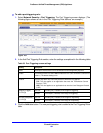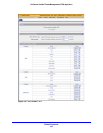
Firewall Protection
183
ProSecure Unified Threat Management (UTM) Appliance
To edit an IP/MAC binding:
1. In the IP/MAC Bindings table, click the Edit table button to the right of the IP/MAC
binding that you want to edit. The Edit IP/MAC Binding screen displays.
2. Modify the settings that you wish to change (see the previous table).
3. Click Apply to save your changes. The modified IP/MAC binding displays in the IP/MAC
Bindings table.
To remove one or more IP/MAC bindings from the table:
1. Select the check box to the left of each IP/MAC binding that you want to delete, or click
the Select All table button to select all bindings.
2. Click the Delete table button.
Configure Port Triggering
Port triggering allows some applications running on a LAN network to be available to external
applications that would otherwise be partially blocked by the firewall. Using the port-triggering
feature requires that you know the port numbers used by the application.
Once configured, port triggering operates as follows:
1. A computer makes an outgoing connection using a port number that is defined in the
Port Triggering Rules table.
2. The UTM records this connection, opens the additional incoming port or ports that are
associated with the rule in the port triggering table, and associates them with the computer.
3. The remote system receives the computer’s request and responds using the incoming port
or ports that are associated with the rule in the port triggering table on the UTM.
4. The UTM matches the response to the previous request and forwards the response to the
computer.
Without port triggering, the response from the external application would be treated as a new
connection request rather than a response to a request from the LAN network. As such, it
would be handled in accordance with the inbound port-forwarding rules, and most likely
would be blocked.
Note these restrictions on port triggering:
• Only one computer can use a port-triggering application at any time.
• After a computer has finished using a port-triggering application, there is a short time-out
period before the application can be used by another computer. This time-out period is
required so the UTM can determine that the application has terminated.
Note: For additional ways of allowing inbound traffic, see Inbound Rules
(Port Forwarding) on page 133.


















